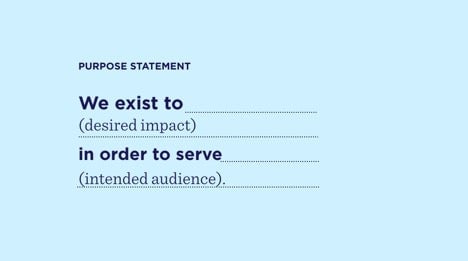This 5-minute thought exercise will help you define your purpose
Over the course of a lifetime, we spend an average of 92,000 hours at work. A growing body of research suggests that it’s better for both us and our employers if we’re working on something that fulfills us.


Over the course of a lifetime, we spend an average of 92,000 hours at work. A growing body of research suggests that it’s better for both us and our employers if we’re working on something that fulfills us.
There’s evidence that purpose-driven companies outperform the market, and studies show that people with a sense of meaning have a 15% lower risk of death, regardless of age. Other studies show that purpose-driven employees are more likely to be high performers and have higher levels of fulfillment in their work.
So, what can you do to bring more meaning to your work?
In our Power of Purpose class, we use the purpose Mad Libs activity (below) to get people thinking about where they find the most meaning in their lives and work, where they’re currently having an impact, and where they want to have future impact. This activity can help you tap into these meaningful moments to start building out a personal and professional purpose statement.
To get started, grab a pen and paper and capture your answers in a few sentences or through simple sketches.
Step 1: Look for Passion
When have you felt a sense of meaning?
When finding your purpose, begin by looking at the past. Don’t merely project into the future or imagine how it might show up. Where has it shown up already?
Think of the moment you’re most proud of, whether at work or in your personal life. These aren’t necessarily your biggest wins, but the things you’ve done that have made you feel good. What were you doing? When have you been at your best personally or professionally? Name and sketch a moment (e.g., projects, scenarios) when you, your team, or your organization shone brightest.
Step 2: Look for People
Who were you serving?
The most powerful purpose is often in service of others—people outside your own walls, like your customers, your community, or society at large. When you look back at your meaningful moments personally or professionally, who were you working to help? Be specific.
Step 3: Look for Impact
What impact did you have?
When you consider the people that you served, what’s the impact you had on their lives? How did they benefit from the work that you do? Also ask, what’s the impact you want to have? And how do you want to improve people’s lives?
Step 4: Why You Exist
Now, bring these ingredients together into a simple purpose statement. Stretch beyond what you’re currently doing and imagine the impact you want to have in the future.
“I/We exist to __________ (desired impact) in order to serve __________ (intended audience).”

How’d it go? Have you come up with a compelling purpose in service of others? These Mad Libs might not be poetry, but they get the core of why you do what you do. Once you have something that feels directionally right, you’re ready for the hard work of rewriting that into something simple that sings, like the following examples:
“We exist to make your world a safer place.” (IAG)
“We are a global design company committed to creating positive impact.” (IDEO)
“We exist to help people on their path to better health.” (CVS)
We know that creating an authentic and lasting purpose can be a challenge. But, we find that individuals are more likely to own a purpose they help create. So, if you’re building a purpose for your team or your company, make your people part of the process. Define a purpose that unifies them. Ask them, who should we serve? What impact do we want to have?
Joe Brown is a portfolio director at IDEO’s San Francisco studio.